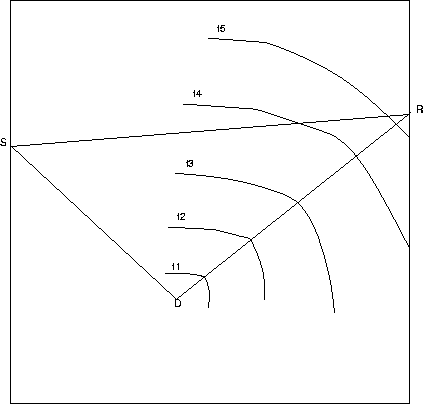




Next: Crosswell seismic modeling
Up: REVERSE-TIME CROSSWELL DEPTH MIGRATION
Previous: REVERSE-TIME CROSSWELL DEPTH MIGRATION
To describe modeling, let us consider the 2-D geological medium
shown in Figure 1.
It contains a point diffractor D in an arbitrary low-wavenumber
velocity background.
The recording geometry contains a source S located at one well and a
series of receivers located at another well.
During the modeling process, the direct wave emitted from the source S
excites the diffractor D at a time equal to the minimum traveltime tSD
from the source S to the diffractor D, according to Fermat's principle.
The diffractor D generates diffraction as rays DR that are recorded by
the receivers. The diffraction wavefront expands from the diffractor.
The direct wave SR does not pass through the diffractor D
and thus does not bear information about the diffractor. The direct wave
is muted before the data is input to the migration imaging process.
Modeling by the finite-difference method represents the wave equation by
finite-differencing. The low-wavenumber velocity background and the
high-wavenumber velocity heterogeneity are represented as attributes assigned
to the finite-difference grids. Each grid point is treated as a point
diffractor (or secondary source). The strength of each secondary source
is proportional to the reflectivity at that location.
The recorded data are the history wavefields at the
recording grid points (Mitchell, 1969; Alford et al., 1974; Claerbout, 1976;
McMechan 1985).
During the process of modeling, the low-wavenumber velocity background
governs the wave propagation, and the high-wavenumber velocity heterogeneity
generates the diffractions.
Crosswell seismic survey is usually conducted at a subsurface segment
of the well that covers the target zone;
thus, during the numerical modeling process, the absorbing
boundary conditions of Clayton and Engquist (1977) are applied along
the four sides of the grid to simulate a whole space for wave propagation.
Migration is the
process that backprojects the recorded diffraction wavefields from the
recording boundary into the low-wavenumber velocity background to
locate the diffractors,
which constitutes of the high-wavenumber velocity heterogeneity.
What is needed as additional input is a
low-wavenumber velocity background model that governs the wave propagation.
Migration produces the image of high-wavenumber velocity
heterogeneity, that is, the locations and strengths of the diffractors.
Reverse-time depth migration projects the recorded diffraction wavefields
back into the low-wavenumber velocity background
by taking the recorded data as boundary
values![[*]](http://sepwww.stanford.edu/latex2html/foot_motif.gif) of a finite-difference grid and running backward through time (McMechan, 1983).
The diffraction wavefront focuses toward the location of
the original diffractor.
At time tSD, all the energy that was diffracted at D will be
focused at D. The value of the backpropagating wavefields at the particular
grid point of D is extracted and
then added as reflectivity into the image plane
at the same spatial location (Chang and McMechan, 1986). As the wavefields
continue to propagate backward in time, the focused energy at D defocuses
and continues to backpropagate in the way each contribution originates.
Each grid point is treated as a point diffractor and is imaged accordingly.
of a finite-difference grid and running backward through time (McMechan, 1983).
The diffraction wavefront focuses toward the location of
the original diffractor.
At time tSD, all the energy that was diffracted at D will be
focused at D. The value of the backpropagating wavefields at the particular
grid point of D is extracted and
then added as reflectivity into the image plane
at the same spatial location (Chang and McMechan, 1986). As the wavefields
continue to propagate backward in time, the focused energy at D defocuses
and continues to backpropagate in the way each contribution originates.
Each grid point is treated as a point diffractor and is imaged accordingly.
Geometry
Figure 1 A crosswell recording
geometry and demonstration of modeling and migration. During modeling,
the diffraction wavefront expands from diffractor D. During reverse-time
migration, the diffraction wavefront focuses toward diffractor D.
|
|  |






Next: Crosswell seismic modeling
Up: REVERSE-TIME CROSSWELL DEPTH MIGRATION
Previous: REVERSE-TIME CROSSWELL DEPTH MIGRATION
Stanford Exploration Project
11/17/1997
![[*]](http://sepwww.stanford.edu/latex2html/foot_motif.gif) of a finite-difference grid and running backward through time (McMechan, 1983).
The diffraction wavefront focuses toward the location of
the original diffractor.
At time tSD, all the energy that was diffracted at D will be
focused at D. The value of the backpropagating wavefields at the particular
grid point of D is extracted and
then added as reflectivity into the image plane
at the same spatial location (Chang and McMechan, 1986). As the wavefields
continue to propagate backward in time, the focused energy at D defocuses
and continues to backpropagate in the way each contribution originates.
Each grid point is treated as a point diffractor and is imaged accordingly.
of a finite-difference grid and running backward through time (McMechan, 1983).
The diffraction wavefront focuses toward the location of
the original diffractor.
At time tSD, all the energy that was diffracted at D will be
focused at D. The value of the backpropagating wavefields at the particular
grid point of D is extracted and
then added as reflectivity into the image plane
at the same spatial location (Chang and McMechan, 1986). As the wavefields
continue to propagate backward in time, the focused energy at D defocuses
and continues to backpropagate in the way each contribution originates.
Each grid point is treated as a point diffractor and is imaged accordingly.
